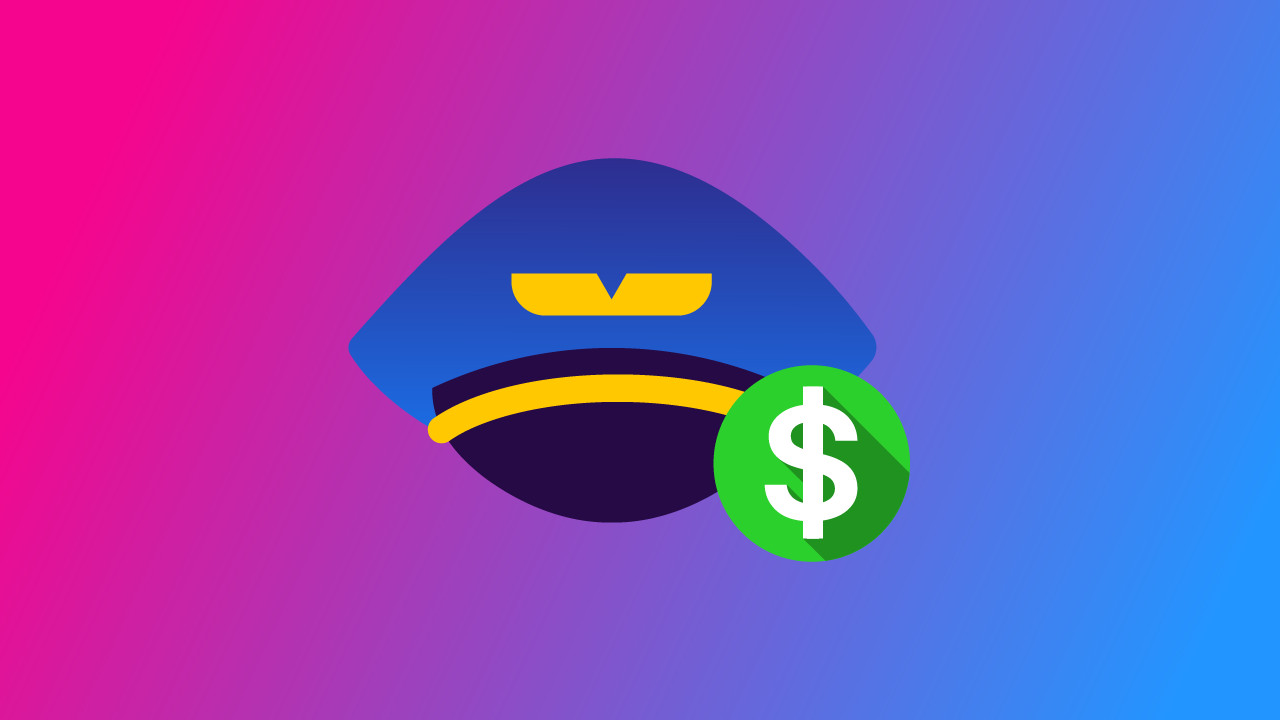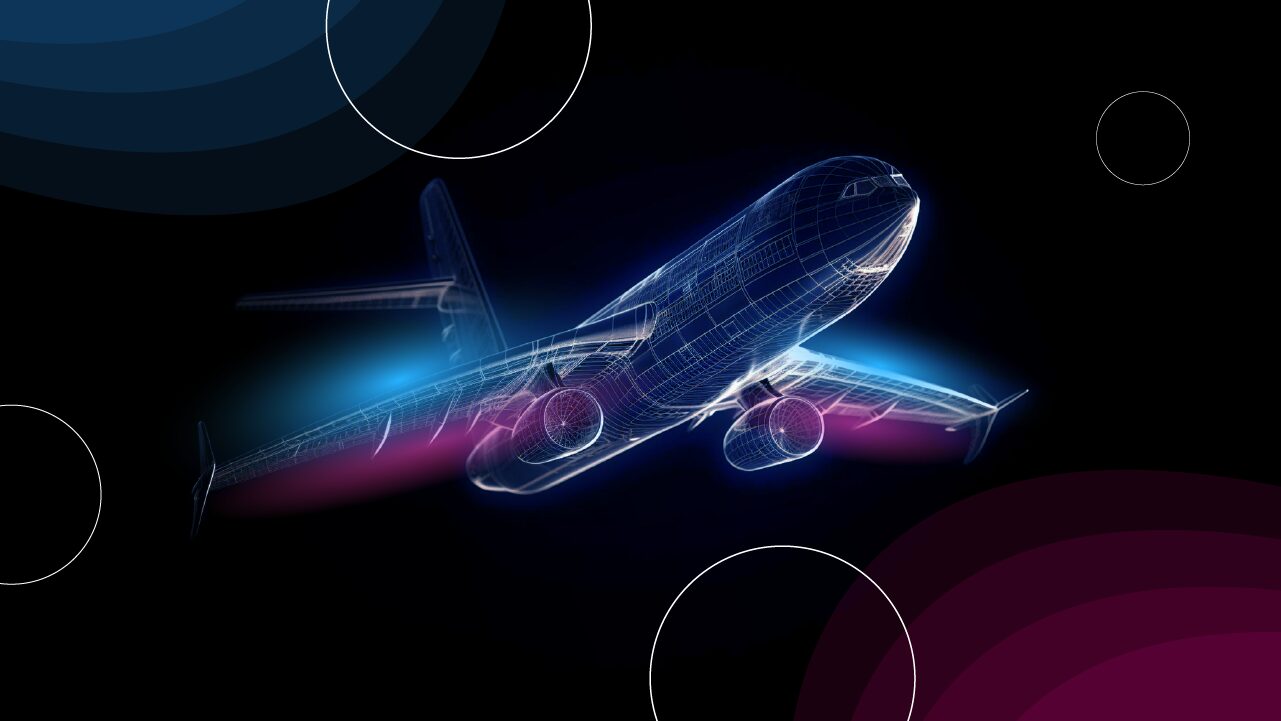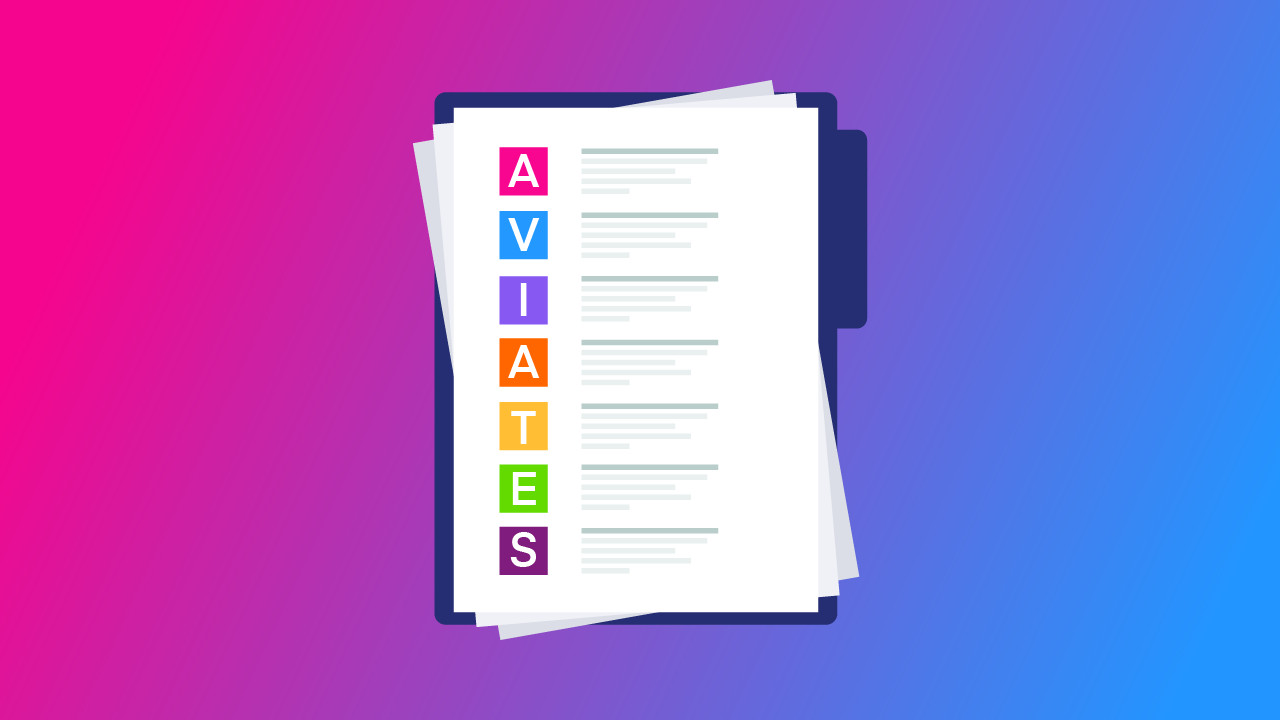-
Key Takeaways
-
How Much Does It Cost To Become a Private Pilot?
- Flight Training
- Miscellaneous Fees
- The Factors that Affect Costs
-
Advanced Licenses and Ratings
- Instrument Rating
- Commercial Pilot License
- Multi-Engine Rating
- Airline Transport Pilot Certificate
-
Total Cost Overview for Airline Pilots
- Key Factors That Drive Total Costs
- Training Schedule: Full-Time vs. Part-Time
- Additional Expenses Beyond Licenses and Ratings
-
Ways to Fund Your Pilot Training
- Financing Options for Pilot Training
- Airline and Flight School Sponsorship Programs
-
Is It Financially Worth It to Become a Pilot?
- Earnings Potential and Career Growth
- The Demand for Pilots
- Return on Investment Timeline
- Factors That Affect Financial Worth
-
Conclusion
Do you dream of being a pilot? Before you start your journey, it’s important to understand the money you’ll need. The cost depends on things like what type of license you want, what training program you choose, and where you go.
Besides just the cost of tuition, you also need to pay for things like flight time, instructors, classes, tests, and equipment. Some flight schools have all-inclusive packages, but make sure to check what’s included so you don’t get any surprises.
In this guide, we’ll walk you through the different costs of becoming a pilot, from basic licenses to advanced ratings, and share options that might help make the journey more affordable.
Key Takeaways
- Expect certification costs, aircraft rental, instructor fees, ground school, exams, and extras.
- Your total expenses will depend on other factors such as location, duration, and training program.
- Check out loans, scholarships, or grants that will help you manage the cost of flight training.
- While training comes with significant costs, the rewards are worth the investment.
How Much Does It Cost To Become a Private Pilot?
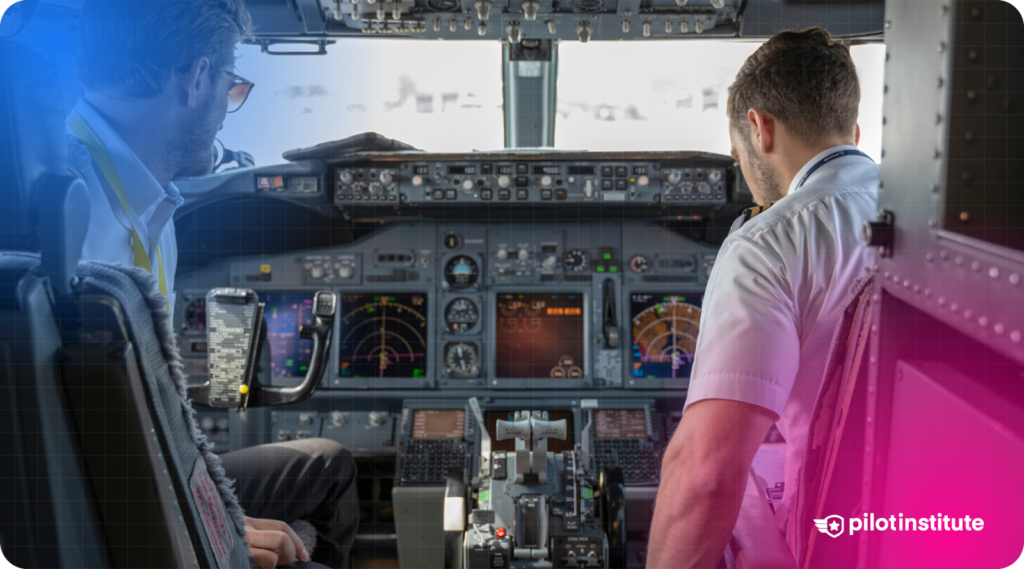
Your Private Pilot License (PPL) will be the foundation of your life in the sky. Whatever your flying goals are, this is the first certificate you’ll need to earn. With your PPL, you’ll be able to fly small aircraft for personal trips.
Are you wondering how much it’ll cost? Let’s break down the bill.
Flight Training
Flight training is where the bulk of your money goes. You can take two training paths to certification: Part 61 and Part 141. Whichever you choose will come with its own requirements and, ultimately, its own cost.
Consider these timeframes for getting your PPL:
- FAA Minimum (Part 61): 40 hours
- FAA Minimum (Part 141): 35 hours
- National Average: ~60–75 hours
(based on data from flight schools, AOPA, and FAA studies)
The FAA requires at least 40 flight hours for a PPL under Part 61 and 35 hours under Part 141. But is there more to their difference than just training hours?
Let’s take a closer look at the first fork in your path.
Part 61
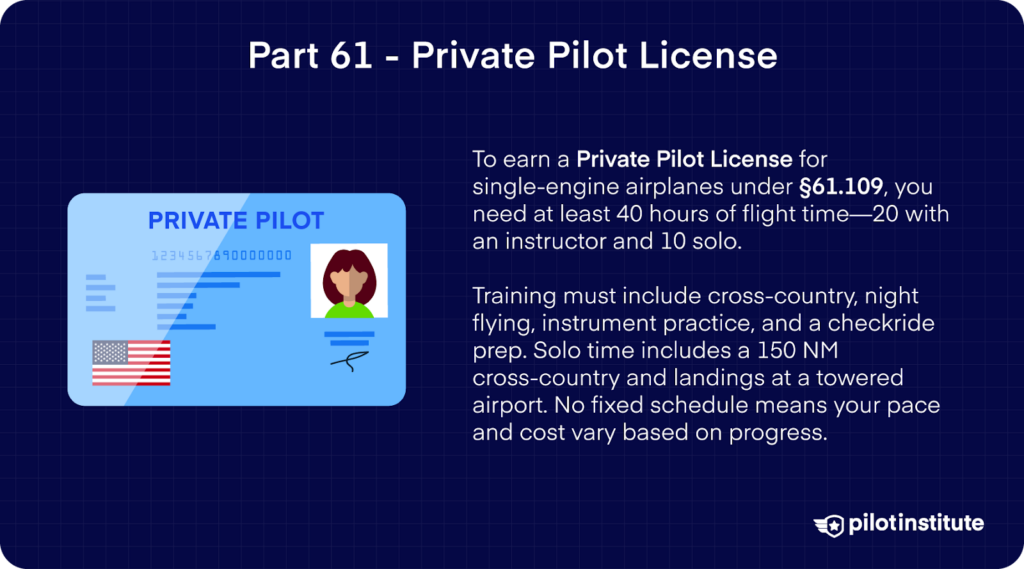
14 CFR Part 61 lays out the rules and requirements for Part 61 training, hence the name. You could say this is the more flexible way to become a pilot.
You train with a Certified Flight Instructor (CFI) and follow a less rigid structure than other programs. You can fly as often (or as little) as you want. If you have other commitments like school or work, this is a great option.
What are the requirements? To get your PPL for a single-engine airplane, you need:
- To be at least 17 years old.
- To have at least a Class 3 Medical Certificate.
In terms of flight experience, you’ll need at least 40 hours of total flight time, and it’s broken down as follows:
- Flight training with an instructor (at least 20 hours).
- 3 hours of cross-country flying (flights over 50 nautical miles from where you started).
- 3 hours of night flying, including:
- One cross-country flight over 100 nautical miles.
- 10 takeoffs and 10 full-stop landings at night.
- 3 hours of instrument training, covering:
- Flying only by instruments (no outside visual references).
- Basic maneuvers like level flight, climbs, descents, and turns.
- Recovering from unusual flight attitudes.
- Using navigation systems and radios.
- 3 hours of prep for the practical test, done within 2 months of the test.
- Solo flight time (at least 10 hours).
- 5 hours of solo cross-country flying.
- One solo cross-country flight of at least 150 nautical miles, with:
- Full-stop landings at three different airports.
- One segment of the flight covering 50+ nautical miles in a straight line.
- 3 solo takeoffs and landings at an airport with a control tower.
Part 61 has no fixed syllabus, so getting your pilot license depends mostly on your schedule and how quickly you can progress.
Your flight instructor will use their judgment to determine if you’re ready for a checkride. Because of this, the duration of training varies significantly from one person to another, and, in the end, the cost of your training.
PPL Costs
Training for your PPL in a flight school can come as a package, including grounds, exam, and checkride fees.
But if you want to arrange for the tests yourself, the price of the FAA knowledge test is usually around $175.
There is no charge if you take the practical test (checkride) from an FAA inspector. But if you take the test from an FAA-designated pilot examiner, you will have to pay, and the price will depend on the examiner and your location.
Did you know that you can do your ground school online? This is an excellent option if you want something more flexible and lighter on the wallet. For comparison, your grounds in a flight school can cost thousands of dollars.
You can save a lot more time and money when you take an online PPL ground course that complies with all the FAA requirements, complete with CFI endorsement, for just around $200.
Generally speaking, though, training for a PPL under Part 61 can amount to as low as $8,000 and as high as $19,000.
Why is the range this broad? We’ll get to that in a moment.
Part 141
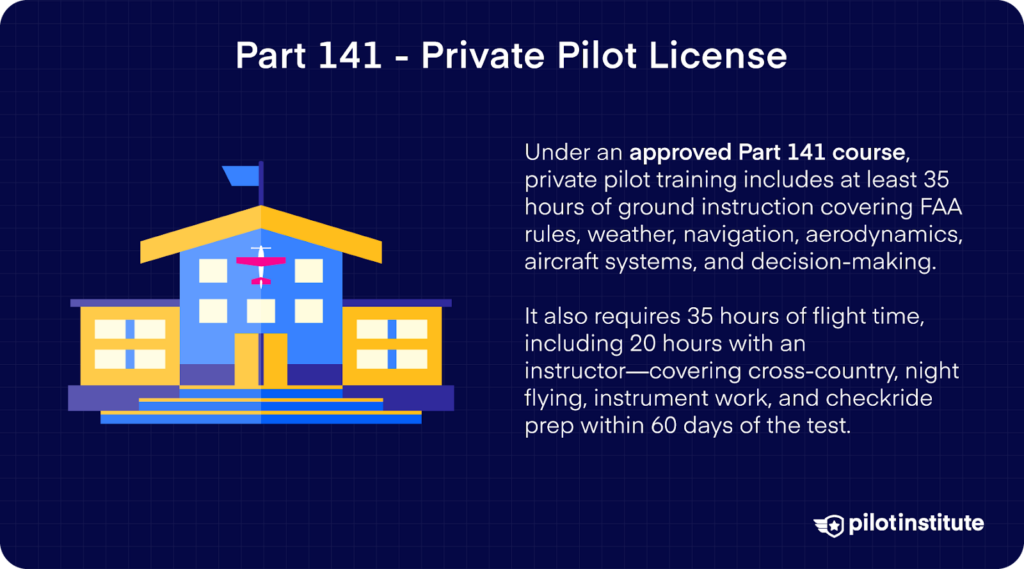
For now, let’s talk about your second option: Part 141 training.
Your training under Part 141 will follow a strict syllabus and comprehensive lesson plan. This is what sets it apart from Part 61.
You must also pass stage checks, where students will be tested on their proficiency at each stage of training. As students who enroll in Part 141 schools almost always start training as a group, most tend to complete it around the same time. This isn’t something that is commonly practiced under Part 61.
So, what will you need to earn your PPL? If you’re training under Part 141, the total flight time required is a bit lower: 35 total flight hours instead of 40. While 35 hours is the FAA minimum for Part 141, most students complete more hours before they’re ready for the checkride.
Here’s how it breaks down:
- Flight training with an instructor (at least 20 hours).
- 3 hours of cross-country flying (flights over 50 nautical miles).
- 3 hours of night flying, including:
- One cross-country flight over 100 nautical miles.
- 10 takeoffs and 10 full-stop landings at night.
- 3 hours of instrument training, covering:
- Flying only by instruments (no outside visual references).
- Basic maneuvers like level flight, climbs, descents, and turns.
- Recovering from unusual flight attitudes.
- Using navigation systems and radios.
- 3 hours of prep for the checkride, done within 60 days of the test.
- Solo flight time (at least 5 hours).
- One solo cross-country flight of at least 100 nautical miles, with:
- Full-stop landings at three different airports.
- One segment of the flight covering 50+ nautical miles in a straight line.
- 3 solo takeoffs and landings at an airport with a control tower.
- One solo cross-country flight of at least 100 nautical miles, with:
And since you’ll be under Part 141, you must also pass stage checks and a final test as part of the approved curriculum.
The training programs that flight schools offer under Part 141 are usually integrated. But despite the lower required hours, Part 141 training programs still tend to cost more than Part 61 since they’re more rigorous and intensive. Their PPL courses can go for around $9,000 to $28,000.
Miscellaneous Fees
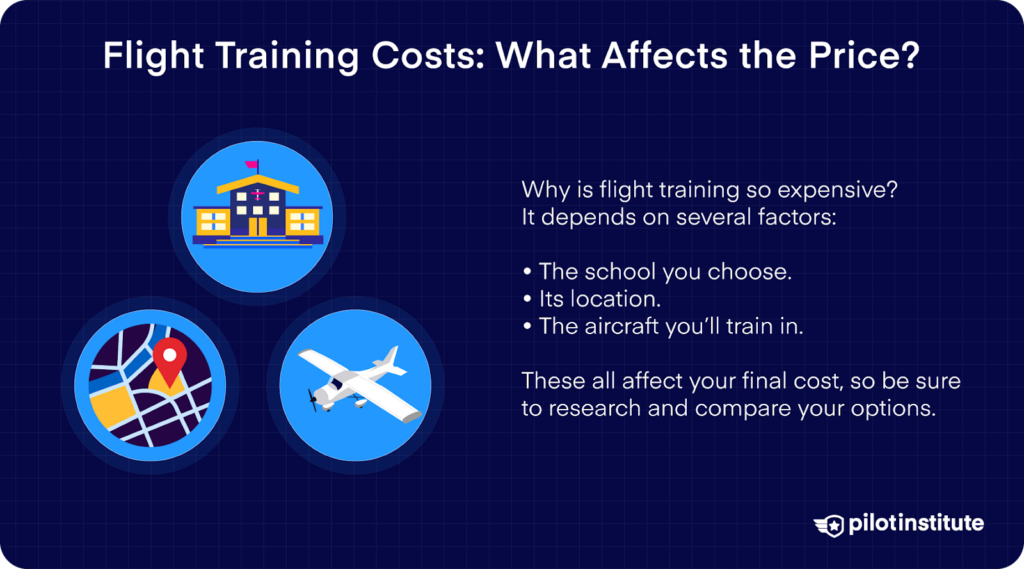
Beyond the obvious costs, watch out for miscellaneous fees that can sneak up on you. For example, some airports charge small landing fees. And if you’re in a flying club, you’ll need to pay annual membership dues.
The minimum medical certificate required for a PPL is Class 3. The exams for your medical certificate can vary depending on the Aviation Medical Examiner (AME) and your location. It’s still good to know, though, that the FAA doesn’t charge for issuing your medical.
You’ll also need the right flying gear. Depending on quality and features, a brand-new aviation headset can be priced anywhere from $100 to $1,200. But if you happen to already have an old one, just $2 to $50 can get your headset back to peak condition!
Flight bags typically go for around $20 to $400. And while you still can use a traditional paper logbook, the FAA now allows you to log your time in a digital logbook app!
Your flight school might also require you to have certain navigation tools, books, and study materials.
How can you stay on the safe side? It’s a good idea to set aside an additional $500 to $1,000 for these smaller but necessary expenses.
These upfront purchases might seem steep, but they’re mostly one-time investments that will serve you well throughout your training.
The Factors that Affect Costs
Here’s where we get to the disclaimer. Why is the price range for flight training so broad?
Keep in mind that these costs can vary depending on several different factors. So, regarding this, you should answer the following questions:
- Which school do you plan to go to?
- Where is it located?
- What aircraft type will you train in?
All of these factors and more can impact your final bill, so it’s important to do your own research and examine the options available to you.
Advanced Licenses and Ratings
Earning your PPL is just the first step in your life as a pilot. Are you planning to make a career out of flying? Advanced licenses and ratings open you up to new opportunities, but they also come with additional expenses.
Now, let’s take a look at your next steps and their price tags.
Instrument Rating
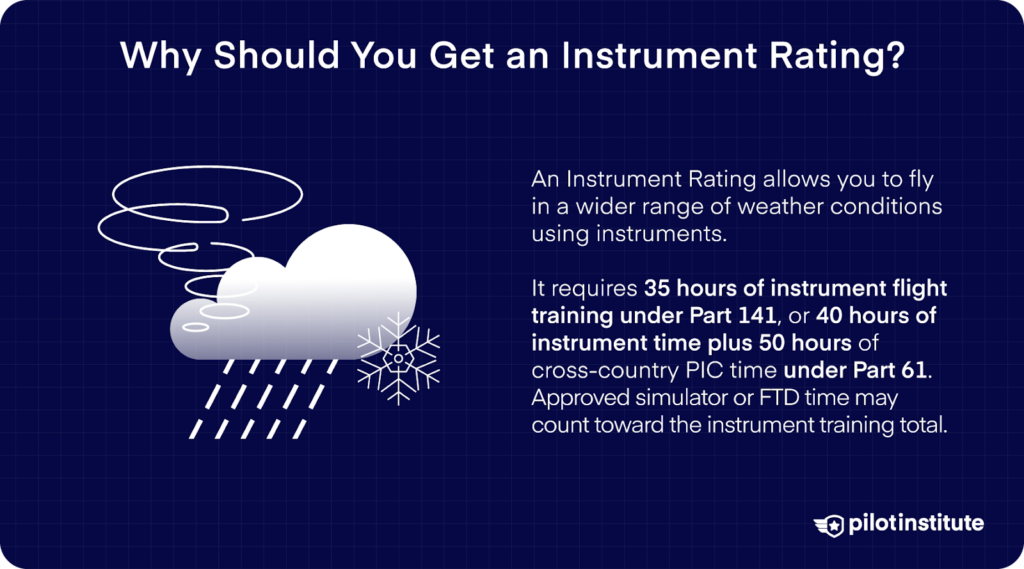
With an Instrument Rating (IR), you’ll be able to fly in a broader range of weather conditions, relying on instruments instead of visual cues.
It’s a must-have for professional pilots since you’ll need to learn how to fly in Instrument Flight Rules (IFR). But even if you’re sticking to your PPL, its value comes in giving you more flexibility and safety.
Part 61
To get your IR under Part 61, you’ll need 50 flight hours of cross-country time as PIC, and 40 hours of actual or simulated instrument time.
These 40 hours are further broken down as follows:
- At least 15 hours must be with an instructor who has an instrument-airplane rating.
- 3 hours of instrument training within 2 months of the check ride.
- One instrument cross-country flight with an instructor, including:
- A 250-nautical-mile route.
- Three different types of instrument approaches using navigation systems.
- A flight plan filed with ATC and flown under instrument flight rules (IFR).
When it comes to simulator time, here’s what the regulation says:
- Full flight simulator or Flight Training Device (FTD):
- Up to 30 hours if done under a Part 142 training center.
- Up to 20 hours if not done under Part 142.
- Aviation Training Devices (ATD):
- Up to 10 hours in a Basic ATD (BATD).
- Up to 20 hours in an Advanced ATD (AATD).
- Maximum credit limit:
- No more than 20 total hours can be counted from any combination of simulators, FTDs, or ATDs, except when using a full flight simulator under Part 142 (which allows 30 hours).
Part 141
If you’re under Part 141, you’ll need 35 hours of instrument training for an initial rating. How is this broken down?
- You’ll need to make at least one IFR cross-country flight, including:
- At least 250 nautical miles along airways or ATC-directed routing.
- One segment of at least 100 nautical miles in a straight line.
- An instrument approach at each airport.
- Three different types of instrument approaches using navigation systems.
Next, here are the simulator and training device allowances:
- Full Flight Simulator (FFS) can account for up to 50% of total flight training hours.
- Flight training devices & AATD can account for up to 40% of total flight training hours.
- BATD can account for up to 25% of total flight training hours.
- Maximum combined simulator/FTD/ATD use: 50% of total training hours.
An Instrument Rating generally amounts to around $10,000 to $14,000 under Part 61, and around $7,000 to $14,000 under Part 141. Remember that costs will also depend on your aircraft type, location, and training pace.
Commercial Pilot License
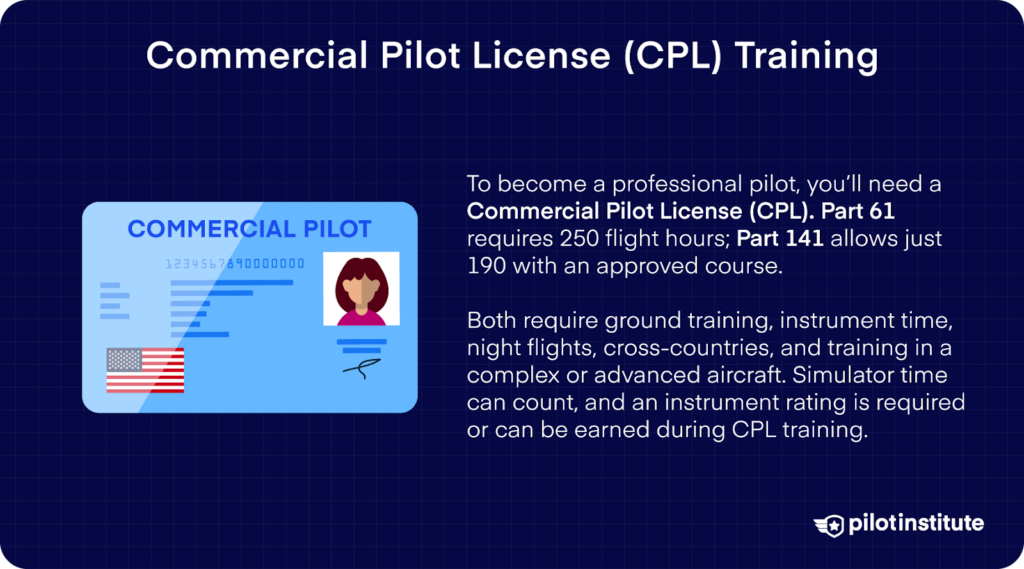
Do you want to become a professional pilot? Then, you’ll need a Commercial Pilot License (CPL). It will give you opportunities to work in cargo flights, aerial tours, or other commercial operations.
Part 61
To earn your CPL under Part 61 for a single-engine airplane, you need at least 35 hours of ground training and 250 total flight hours, which should include:
- 100 hours in powered aircraft, with at least 50 hours in airplanes.
- 100 hours as Pilot-in-Command (PIC), including:
- 50 hours in airplanes.
- 50 hours of cross-country time, with at least 10 hours in airplanes.
- Required flight training (at least 20 hours with an instructor)
- 10 hours of instrument training (5 hours must be in a single-engine airplane).
- 10 hours in a complex, turbine-powered, or technically advanced airplane (TAA).
- Take note that a TAA must have:
- Primary Flight Display (PFD) with airspeed, attitude, heading, turn coordination, altitude, and vertical speed indicators.
- Multifunction Display (MFD) with a moving map and GPS navigation.
- Two-axis autopilot integrated with navigation and heading systems.
- All displays must be continuously visible.
- Take note that a TAA must have:
- Two cross-country flights:
- One 2-hour daytime flight, over 100 nautical miles straight-line distance.
- One 2-hour nighttime flight, over 100 nautical miles straight-line distance.
- 3 hours of check ride prep with an instructor, done within 2 months of the test.
- Solo or PIC flight time (at least 10 hours)
- One solo cross-country flight of at least 300 nautical miles, including:
- Landings at three different airports.
- One leg of at least 250 nautical miles in a straight line.
- 5 hours of night VFR flying, including:
- 10 takeoffs and 10 full-stop landings at an airport with a control tower.
- Simulator and FTD Credit
- Without Part 142 training:
- Up to 50 hours can be logged in a simulator or FTD for an airplane rating.
- With Part 142 training (FAA-approved training center):
- Up to 100 hours can be logged in a simulator or FTD for an airplane rating.
- Special Exception:
- If training under Part 142, a candidate with 190 total hours may meet the CPL requirements if they complete an FAA-approved commercial pilot course.
Remember that this is the bare minimum, and that most pilots log more than 250 hours before taking the checkride.
Part 141
But for a Part 141 flight school, alongside 35 hours of ground training, you can earn your CPL with just 190 total flight hours.
This should include 120 hours of CPL flight training for an airplane single-engine rating, which has at least:
- 55 hours of flight training with an instructor, covering:
- 10 hours of instrument training, including:
- 5 hours in a single-engine airplane.
- 10 hours in a complex, turbine-powered, or technically advanced airplane (TAA).
- Two cross-country flights:
- One 2-hour daytime flight, over 100 nautical miles straight-line distance.
- One 2-hour nighttime flight, over 100 nautical miles straight-line distance.
- 3 hours of check ride prep within 60 days of the test.
- 10 hours of instrument training, including:
- At least 10 hours of solo or PIC flight time
- One solo cross-country flight, including:
- At least 3 landings at different airports.
- One segment of at least 250 nautical miles straight-line distance (or 150 NM if training in Hawaii).
- 5 hours of night VFR flying, including:
- 10 takeoffs and 10 full-stop landings at an airport with a control tower.
- One solo cross-country flight, including:
- Simulator and FTD credit
- FFS credit can count for up to 30% of the total flight training hours.
- FTD credit can count for up to 20% of the total flight training hours.
- Together, use of FFS and FTD combined cannot exceed 30% of total training hours.
On top of that, according to the eligibility requirements for enrollment, you must already have a PPL, which requires at least 35 flight hours.
You’ll also need to have an instrument rating. But if you don’t already have one, you have the option to complete an IR training course alongside CPL training. This is also going to take 35 flight hours.
When you sum it all up, you should have at least 190 total flight hours before you obtain your CPL.
CPL Cost
You can do your training in many different ways. There are training programs that offer CPL as an add-on course, which you can take after getting your PPL. Universities and flight schools also offer CPL courses as an integrated program starting from zero.
Standalone CPL courses can typically cost up to $50,000. This will depend on the program offerings and your flight experience that can be credited to the requirements.
For example, if you already have the 250 required flight hours under Part 61, your additional training for a CPL can be priced at just around $3,000!
But if you’re going all-in from zero to CPL, you may have to invest around $80,000. These programs are usually offered in Part 141 flight schools or as a part of a college degree. They’ll cover your PPL and IR–sometimes even your Multi-Engine (ME) rating–on top of your CPL!
Multi-Engine Rating
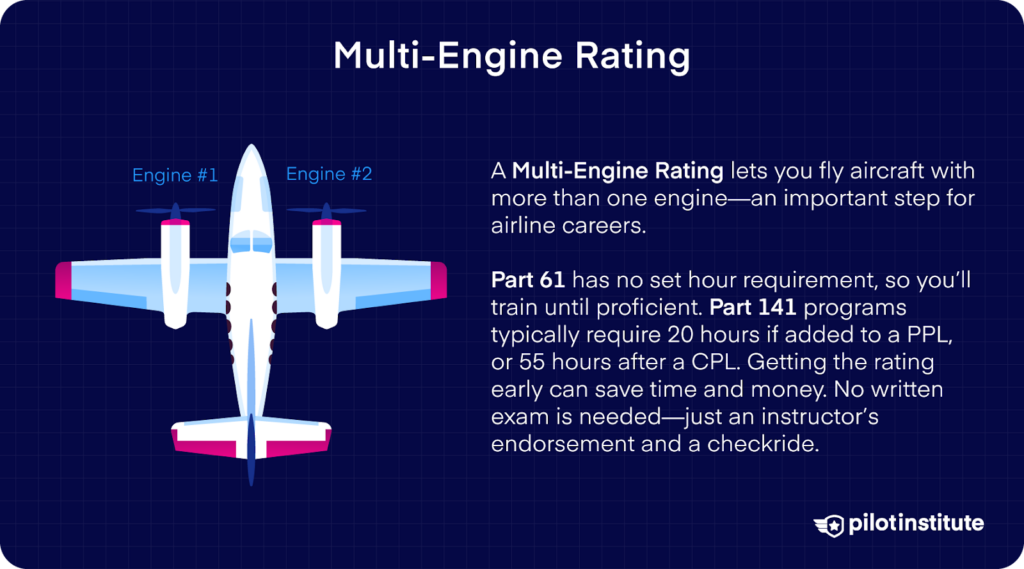
What’s a multi-engine rating? It lets you fly aircraft with more than one engine. This is great if you want an airline career and a higher-paying job.
Unlike the previous certificates, there’s no minimum flight time requirement to get your ME Rating under Part 61. But of course, you’ll still need to put in the hours to develop your skills in order to pass the checkride.
Under Part 141, you’ll have to meet a certain number of training hours depending on your certification. It’s best to add an ME rating as early as possible.
Why is this? To demonstrate, if you add an ME rating to your PPL, you’ll only need 20 hours of flight training. But if you add the rating after getting your CPL, it’s an extra 55 hours of training in a multi-engine aircraft.
Here’s what the fine print says:
Part 141 ME Rating Requirements for PPL
- 20 hours of flight training in a multi-engine airplane.
- Simulator/FTD credit: Up to 4 hours total, with a maximum of 3 hours in an FTD.
- Required training includes:
- 3 hours of cross-country training.
- 3 hours of night training, including:
- One cross-country flight over 100 nautical miles.
- 10 takeoffs and 10 full-stop landings at night.
- 3 hours of instrument training, covering:
- Flying only by instruments (no outside visual references).
- Recovering from unusual attitudes.
- Using navigation and radar services.
- 3 hours of check ride prep within 2 months of the test.
Part 141 ME Rating Requirements for CPL
- 55 hours of flight training in a multi-engine airplane.
- Simulator/FTD credit: Up to 16.5 hours total, with a maximum of 11 hours in an FTD.
- Required training includes:
- 5 hours of instrument training (including partial panel skills and navigation tracking).
- 10 hours in a complex or turbine-powered multi-engine airplane.
- Two cross-country flights (2 hours each):
- One in daytime conditions (at least 100 nautical miles straight-line distance).
- One in nighttime conditions (at least 100 nautical miles straight-line distance).
- 3 hours of check ride prep within 2 months of the test.
Here’s some good news: did you know that you won’t need to take a written exam? This is because your ME is an add-on rating. Instead, you’ll just need an endorsement from your Multi-Engine Instructor (MEI) and pass the practical test.
Along with flight schools, ME rating is also sometimes included in college and university programs as part of a degree curriculum.
However, if you want to pursue your multi-engine rating separately, you can expect to spend around $3,000 to $13,000. Some accelerated programs might go up to $15,000. This will also vary based on the certificate to which you’re adding a multi-engine rating under Part 141.
Airline Transport Pilot Certificate
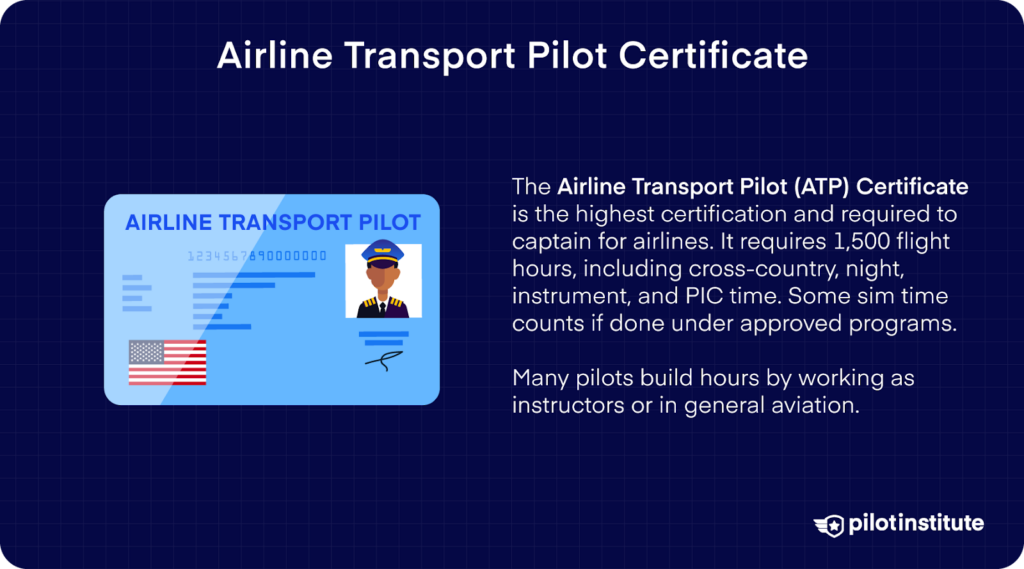
The Airline Transport Pilot (ATP) Certificate is the highest certification you can earn. You’ll need it to act as a captain for airlines. By this point, most of the expenses are tied to logging in the required 1,500 total flight hours.
These hours are split up by 14 CFR, and here’s how it goes:
- Cross-country and night flight requirements
- 500 hours of cross-country time.
- 100 hours of night flight time (up to 25 hours may be substituted by performing extra night takeoffs and landings).
- Flight time in the class of airplane sought
- 50 hours of flight time in the class of airplane for the rating sought.
- Up to 25 hours may be credited from a full flight simulator (FFS) if completed in an approved Part 121, 135, 141, or 142 training program.
- Flight training devices or aviation training devices cannot be used to meet this requirement.
- Instrument flight time requirements
- 75 hours of instrument flight time (actual or simulated).
- Up to 25 hours of simulated instrument time can be credited from an FFS or FTD.
- Up to 50 hours can be credited if the training is done under a Part 142 training center.
- Pilot in command time requirements
- 250 hours as PIC or as SIC performing PIC duties under supervision.
- Must include at least:
- 100 hours of cross-country time.
- 25 hours of night flight time.
- Must include at least:
- 250 hours as PIC or as SIC performing PIC duties under supervision.
- Simulator and flight training device credit
- Up to 100 total hours can be logged in a FFS or FTD, provided the training is done under an approved Part 121, Part 135, Part 141, or Part 142 program.
Working to Build Hours
1,500 is a big number. That’s why a lot of pilots decide to work in general aviation or as a flight instructor. This way, they can get paid while building their hours.
If you want to become a CFI, you’ll need to set aside $5,000 at a Part 61 school, and $8,000 at Part 141. You can study in a flight school, and some college courses also offer CFI certification as a part of their curriculum!
R-ATP
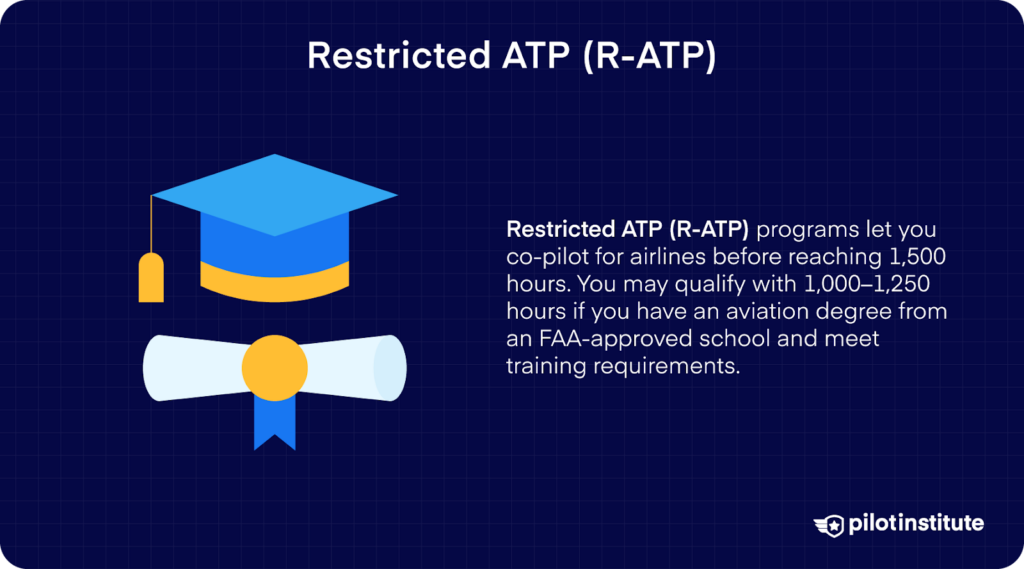
Schools and universities have training programs that will allow you to exercise the restricted privileges of an ATP (R-ATP). With this certification, you can fly as an airline co-pilot until you reach the 1,500-hour threshold.
The qualifications for the R-ATP certificate differ from those of the ATP certificate. You may qualify with less than 1,500 total flight hours, depending on your level education.
What does regulation say? Let’s take a look.
- To qualify with 1,000 hours, you must:
- Hold a bachelor’s degree in aviation from an FAA-authorized institution.
- Complete 60 semester credit hours of FAA-approved aviation coursework.
- Hold a commercial pilot certificate with an instrument rating, with training completed under:
- A Part 141 curriculum at the institution; or
- A Part 141 pilot school with an FAA-approved training agreement.
- Provide official transcripts proving the education and training requirements were met
- To qualify with 1,250 hours, you must:
- Hold an associate’s degree in aviation from an FAA-authorized institution.
- Complete 30 semester credit hours of FAA-approved aviation coursework.
- Hold a commercial pilot certificate with an instrument rating, with training completed under:
- A Part 141 curriculum at the institution; or
- A Part 141 pilot school with an FAA-approved training agreement.
- Provide official transcripts proving the education and training requirements were met.
- If you completed fewer than 60 but at least 30 semester credit hours, you may still qualify with 1,250 hours if all other 1,000-hour R-ATP requirements are met.
Training Programs
But just because you eventually reach 1,500 hours doesn’t mean you immediately qualify for an ATP certificate. You’ll still need to complete an FAA-approved Airline Transport Pilot Certification Training Program (ATP-CTP), after which you’ll be allowed to take the tests for your certificate.
Typically, an ATP certification training program runs for around $4,000. This will cover the training and preparation for your FAA exams.
But if you’re already committed to getting an ATP certificate from the start, you can also take an integrated training course. You can start from zero, from solo, or from your PPL, where your training course will take you through every necessary rating and certification all the way to ATP.
These programs can be priced at around $100,000 starting from zero hours, but this can be lower depending on how much flight experience you’ll be able to credit.
Being an Aircraft Owner
If you want to collect these hours on your own terms, why not go ahead and buy your own aircraft? The costs compared to renting eventually even out, and you’d save yourself a lot of time and anxiety.
Plus, if you see yourself flying regularly after training, having your own aircraft gives you more control. You’ll be able to fly practically anytime you want, be it for personal travel, advanced certifications, or building hours.
Total Cost Overview for Airline Pilots
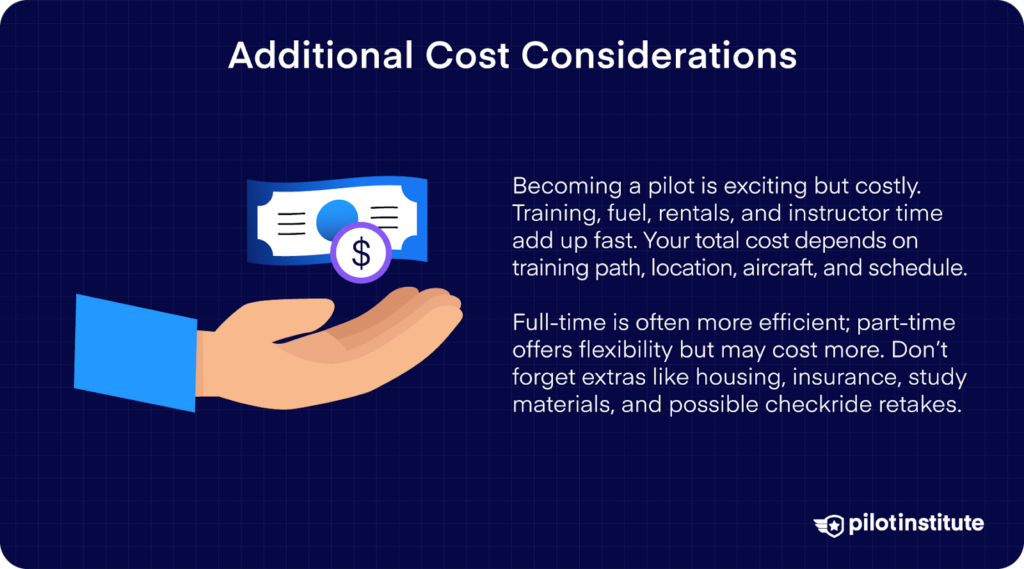
Becoming a pilot is exciting, but it is not cheap. Flight training alone can cost tens—if not hundreds—of thousands. You’ll need to log as many flight hours as you need, which means more money spent on fuel and aircraft rentals.
But remember that the cost of becoming an airline pilot isn’t just about hours and licenses. The numbers we discussed are simply approximations—they’re there to give you a sense of what your expenses might look like.
You could spend more or less than these approximations once you actually get on your journey. Beneath the surface, there are many other variables at play.
So, what other factors can affect your bill?
Key Factors That Drive Total Costs
The training path you choose will play a huge role. Integrated programs tend to be more expensive, but they will get you to the finish line faster.
Modular programs, on the other hand, let you complete each license separately and often at your own pace. The trade-off? This flexibility can come with higher overall costs, especially if your training stretches too long.
Another critical factor will be the location of your training. Of course, you can expect bigger expenses in regions with high fuel prices, expensive landing fees, or premium facilities.
The type of aircraft used for training also affects pricing. Modern ones with advanced avionics cost more to operate, though they may better prepare you for airline environments.
Finally, instructor availability and scheduling affect prices more than you realize. If your instructor’s schedule is inconsistent or the weather gets in the way, training becomes less efficient and, ultimately, more expensive.
Training Schedule: Full-Time vs. Part-Time
We’ve mentioned that your approach to scheduling has a direct effect on your final costs. But how exactly does that work?
Full-time training is often more cost-effective because you’ll be flying consistently. You’ll have less of a need to take on extra flying hours just to regain lost skills.
Students in full-time programs generally progress more efficiently. They complete their training faster and with fewer setbacks.
On the other hand, part-time training offers flexibility if you’re balancing work or other responsibilities. Just note that spreading training over an extended period can lead to higher costs. This is because of skill regression and additional flight hours needed to stay proficient.
At the end of the day, your choice will depend on:
- Your financial situation.
- Your lifestyle.
- How quickly you want to enter the industry.
Additional Expenses Beyond Licenses and Ratings
While flight hours and training programs make up most of the cost, there are also other unavoidable expenses to consider.
- Housing and Living Costs: If your flight school isn’t local, expect additional expenses for rent, food, and transportation.
- Renter’s Insurance: Some schools require their students to carry insurance. These could cost as low as $72 a year for basic liability insurance, while $175 annually can give you more comprehensive coverage. Determine which insurance policy works best for you.
- Study Materials: Books, online courses, and test preparation tools can be priced up to $200, possibly more, throughout your training. But the good news is you can have access to some online resources for absolutely no charge!
- Skill Tests and Re-Examinations: Failing a checkride means paying for retakes, which include fees for aircraft rental, examiner costs, and possibly extra instruction hours.
Ways to Fund Your Pilot Training
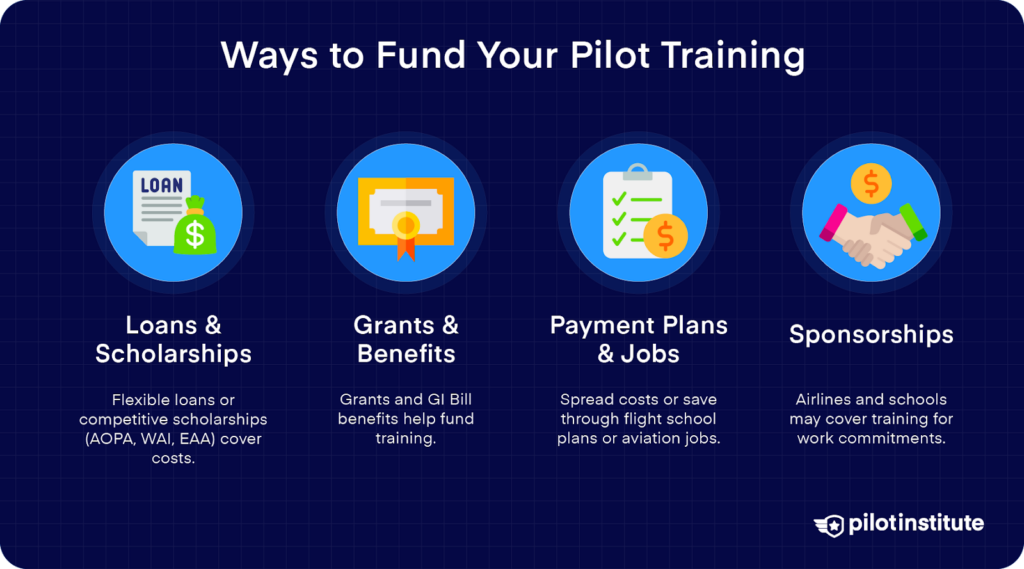
Are the numbers starting to make you feel overwhelmed? Well, fortunately, you also have a lot of funding options to choose from.
From scholarships and loans to airline sponsorships, each option comes with its requirements and benefits. Let’s examine each one.
Financing Options for Pilot Training
- Personal Loans: Some financial institutions offer flight training loans. These loans often come with flexible repayment plans, and some lenders even allow deferred payments until training is complete.
Interest rates vary based on credit history, so you can improve your terms when you secure a co-signer.
- Scholarships: Plenty of organizations offer aviation scholarships. Just some for example are:
- The Aircraft Owners and Pilots Association (AOPA).
- Women in Aviation International (WAI).
- Experimental Aircraft Association (EAA).
Their scholarships can cover partial or complete prices for licenses and ratings. Just keep in mind that they are highly competitive. You’ll need to do well with essays and interviews, and show a passion for aviation.
- Grants: Some government programs and aviation foundations provide grants to aspiring pilots. Unlike loans, grants don’t need to be repaid. Availability varies by region, and eligibility may depend on income level or specific demographics.
- Veteran Benefits: In the United States, veterans can fund pilot training through military benefits like the GI Bill. You’ll have to meet certain requirements to qualify, like attending VA-approved schools.
- Flight School Payment Plans: Some schools offer in-house financing or payment plans. These will let you spread training costs over time. But while convenient, they might include additional fees or higher rates.
Are loans and scholarships not for you? No need to worry. There are other ways to fund your training, like working in the aviation industry.
Flight schools and airports often need line service technicians, front desk staff, and aircraft cleaners. You can save up for flight training by working these jobs and even receive discounts on training fees. Plus, you’ll have an excellent opportunity to build your network and gain exposure to the field.
Airline and Flight School Sponsorship Programs
Many airlines and flight schools offer programs to help you cover the cost of pilot training. In exchange, you’ll often have to commit to work for them afterward.
So, where can you apply for these programs?
Big companies like Delta, United Airlines, and Lufthansa have cadet programs that can either reduce or entirely cover your training costs. In return, you’ll agree to work for the airline for a set number of years once you’re fully trained.
Some flight schools, like CAE Aviation Academy and L3Harris Flight Academy, partner directly with airlines to give you a clear pathway to work.
Is It Financially Worth It to Become a Pilot?
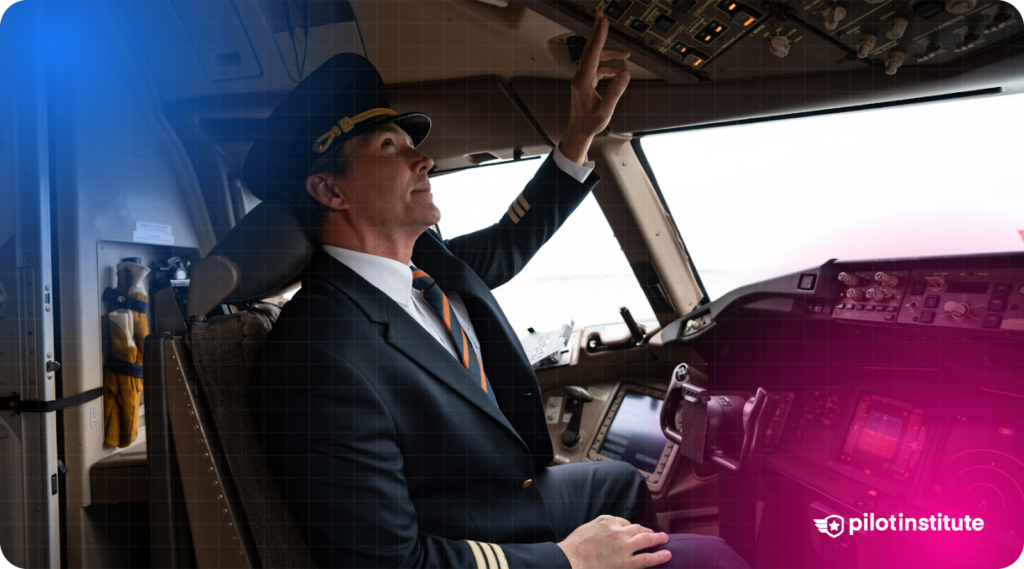
You’ll need to invest significant time and money to become a pilot. But in time, it can lead to one of the most rewarding and lucrative careers out there.
With global demand for pilots and salaries on the rise, you might wonder: is the return on investment worth it?
Earnings Potential and Career Growth
Like in any job, your salary will depend on your experience, your role, and the size of the company. Flight instructors typically earn around $60,000 per year(according to 2025 estimates).
Regional airline pilots usually start with salaries of around $100,000 annually(according to 2025 estimates). PSA Airlines even recently offered a bonus of $175,000 for direct entry captains. And once you become a regional captain, you can earn up to around $200,000 per year.
But of course, the major airline salaries are the ultimate prize.
First officers earn around $100,000 annually, depending on the airline and the aircraft they operate. And once you become a captain, this number can triple to $300,000, possibly even higher once you gain enough seniority!
The Demand for Pilots
You might have heard about the global pilot shortage. Factors like increased air travel demand, mandatory retirement ages, and fewer pilots entering the workforce have created a gap that airlines are eager to fill.
It’s actually projected that airlines will need over 600,000 new pilots globally by 2040. This is reassuring news if you’re just starting out.
Return on Investment Timeline
How soon can you see the return on your investment? It will depend on how quickly you progress in your career.
On average, it takes about 5–10 years after earning your Private Pilot License (PPL) to reach a point where your earnings outweigh your training costs.
Regional airline pilots often start repaying training loans early in their careers. They then cover debts and secure financial freedom with major airline salaries.
Factors That Affect Financial Worth
You’ve probably heard of pilots’ sacrifices to get where they are. While the paycheck is attractive, they deal with unpredictable schedules, time away from home, and significant training costs.
But the return on investment isn’t just measured with your salary.
As an airline pilot, you can enjoy travel perks, retirement plans, and healthcare packages. On top of that, many airlines offer bonuses, profit-sharing, and per diem allowances during trips.
Conclusion
Becoming a pilot may seem expensive, but you can make it happen with some clever thinking and planning.
There are lots of ways to get help paying for the costs, like scholarships and programs from airlines. And don’t forget about the rewarding experiences and good pay that come with this career.
So, if flying is what your heart desires, don’t let money stand in your way. Keep pushing towards your dream and use all the tools available to achieve it!
